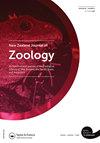怀卡托地区哺乳动物害虫的分布和可检测性
IF 1.1
4区 生物学
Q3 ZOOLOGY
引用次数: 2
摘要
摘要采用系统的相机陷阱阵列,结合生境占用率分析,对怀卡托地区3个主要生境的主要目标害虫按季节分类的存在情况和检测概率进行了估计。相机很容易识别出刷尾负鼠、刺猬、船鼠、野生家鼠和鼬鼠,即白鼬、野生雪貂和鼬鼠作为一个群体。这些数据包括四组估计数,一组是一年中每个季节的15个估计数(5个目标,3个栖息地),总共60个。其中,只有10个(17%)返回了该物种在该季节在该栖息地的检测概率超过50%,假设当时至少有一个个体存在。我们监测的所有害虫种类都出现在牧区。牧场占怀卡托一半以上的土地覆盖面积,因此它支持了大量的物种,即使这些物种在该栖息地并不丰富。因此,旨在保护受保护森林中的本地物种的虫害防治行动需要考虑到从邻近牧场迅速重新入侵受控制地区的重要影响。本文章由计算机程序翻译,如有差异,请以英文原文为准。
Distribution and detectability of mammalian pests in the Waikato Region
ABSTRACT We used systematic arrays of camera traps combined with site-occupancy analyses to estimate the site-specific presence and probability of detection the principal target pests across the three main habitats of Waikato Region, classified by season. Cameras easily identified brushtail possums, hedgehogs, ship rats, wild house mice, and mustelids, i.e., stoats, feral ferrets and weasels taken as a group. The data comprise four sets of estimates, one set of 15 (five targets, three habitats) for each season of the year, total of 60. Of these, only 10 (17%) returned probabilities of detection of more than 50% for that species in that habitat at that season, given that at least one individual was present then. All pest species we monitored were present on pastoral land. Pasture makes up more than half of the land cover of the Waikato, so it supports large numbers even of species that are not abundant in that habitat. Hence, pest control operations intended to conserve indigenous species in protected forests need to allow for the important effects of rapid reinvasions of controlled areas from adjacent pasture.
求助全文
通过发布文献求助,成功后即可免费获取论文全文。
去求助
来源期刊
CiteScore
2.80
自引率
0.00%
发文量
20
审稿时长
>12 weeks
期刊介绍:
Aims: The diversity of the fauna of the southern continents and oceans is of worldwide interest to researchers in universities, museums, and other centres. The New Zealand Journal of Zoology plays an important role in disseminating information on field-based, experimental, and theoretical research on the zoology of the region.

 求助内容:
求助内容: 应助结果提醒方式:
应助结果提醒方式:


